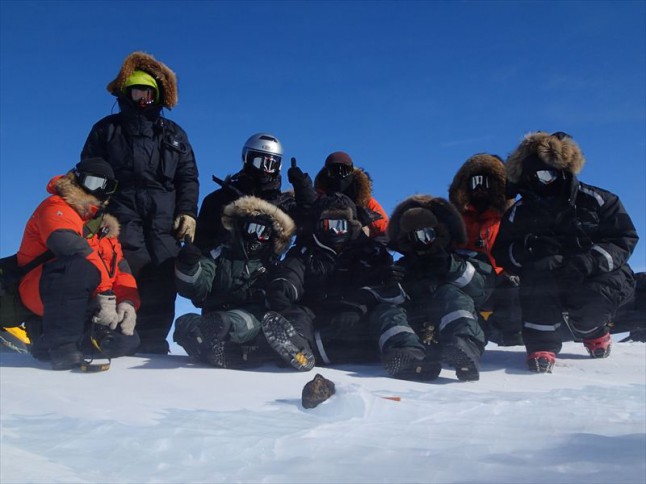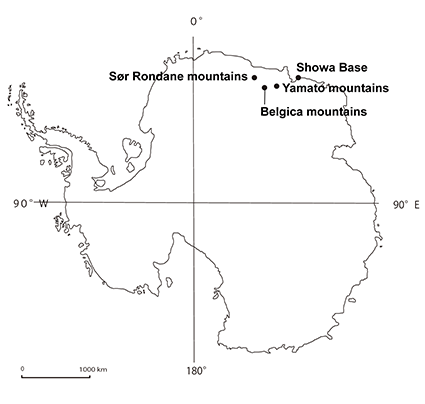History of Antarctic Meteorite Exploration

History of Antarctic Meteorite Exploration
The history of Japanese Antarctic meteorite exploration dates back to 1969, when the 10th Japanese Antarctic Research Expedition discovered nine meteorites. Since then, approximately 17,400 meteorites have been collected in 24 expeditions.
In 1969, the 10th expedition was investigating the ice sheet southeast of the Yamato Mountains when they accidentally discovered nine meteorites. Although only nine meteorites were found, they contained six different types of meteorites, which greatly influenced later meteorite exploration in Antarctica.
The next discovery was of 12 meteorites by the 14th Japanese Antarctic Research Expedition in 1973. Again, this was an accidental discovery made during research for other purposes in the same area. The following year, in 1974, meteorite exploration was declared an objective for the first time, and the 15th expedition to the Yamato Mountains collected 663 meteorites, marking the beginning of Japan's Antarctic meteorite exploration in earnest.
| Year | Expedition Number | Number of collected meteorites | Note | Meteorite Name |
|---|---|---|---|---|
| 1969 | JARE-10 | 9 | First discovery of meteorites in the Yamato Mountains | Yamato-69 |
| 1973-74 | JARE-14 | 12 | Yamato-73 | |
| 1974-75 | JARE-15 | 663 | Organized Meteorite Exploration Begins | Yamato-74 |
| 1975-76 | JARE-16 | 308 | Yamato-75 | |
| 1976-77 | ANSMET | 11 | Japan-U.S. Joint Meteorite Exploration | Allan Hills-76 etc. |
| 1977-78 | ANSMET | 249 | Japan-U.S. Joint Meteorite Exploration | Allan Hills-77 etc |
| 1978-79 | ANSMET | 227 | Japan-U.S. Joint Meteorite Exploration | Allan Hills-78 etc. |
| 1979-80 | JARE-20 | 3697 | Discovery of Lunar Meteorite | Yamato-79/Belgica-79 |
| 1980-81 | JARE-21 | 13 | Yamato-80 | |
| 1981-82 | JARE-22 | 133 | Yamato-81 | |
| 1982-83 | JARE-23 | 211 | Discovery of Lunar Meteorites Continues | Yamato-82 |
| 1983-84 | JARE-24 | 42 | Yamato-83 | |
| 1984-85 | JARE-25 | 59 | Yamato-84 | |
| 1985 | ||||
| 1986-87 | JARE-27 | 817 | Discovery of the largest lunar meteorite | Yamato-86/Asuka-86 |
| 1988 | JARE-29 | 352 | Asuka-87 | |
| 1988 | JARE-29 | 1597 | ||
| 1989 | ||||
| 1990-91 | JARE-31 | 48 | Asuka-90 | |
| 1991 | ||||
| 1992-93 | JARE-33 | 3 | Yamato-92 | |
| 1993 | ||||
| 1994-95 | JARE-35 | 16 | Yamato-94 | |
| 1995-1997 | ||||
| 1998-99 | JARE-39 | 4180 | Micrometeorite collection | Yamato 98/Belgica 98 |
| 1999 | ||||
| 2000 | JARE-41 | 3554 | Micrometeorite collection | Yamato 00 |
| 2001-2008 | ||||
| 2009-10 | JARE-51 | 635 | Belgium-Japan Joint Meteorite Exploration | Asuka 09 |
| 2010 | JARE-52 | 230 | Belgium-Japan Joint Meteorite Exploration | Asuka 10 |
| 2011 | ||||
| 2012 | JARE-54 | 420 | Belgium-Japan Joint Meteorite Exploration | Asuka 12 |
| 2019-2020 | JARE-61 | 66 | Belgium-Japan Joint Meteorite Exploration | Asuka 19 |
Recent Exploration
Meteorite Research in the Sør Rondane Mountains and Nansen Icefield - A Japan-Belgium Collaboration
The 54th Japanese Antarctic Research Expedition (JARE-54) conducted a joint meteorite survey of the Nansen Icefield south of the Sør Rondane Mountains from December 1, 2012, to February 14, 2013, by the Japanese and Belgian teams. As a result, they collected a total of about 420 Asuka meteorites weighing about 75 kilograms. The meteorites collected included a large 18-kilogram chondrite and some rare types, like achondrites and primitive carbonaceous chondrites.

Members of the meteorite exploration team
Location of Meteorite Collection
Japan has found meteorites in several specific areas in Antarctica. These include the exposed ice fields in the Yamato Mountains, the Belgica Mountains, and the region near the Sør Rondane Mountains. The names given to these meteorites, "Yamato" and "Asuka" (the latter is named after the Asuka Base, close to the Sør Rondane Mountains), are based on the locations where they were found.

Location of Meteorite Collection



